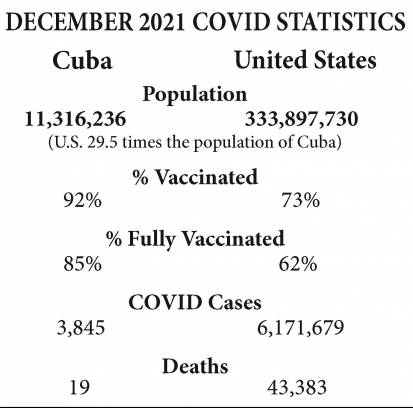Socialist Cuba, despite the 60-year U.S. economic blockade, has made remarkable achievements in combating COVID-19. Cuba has:
- Developed its own vaccines
- Begun sharing these vaccines with other countries
- Achieved a vaccination rate of over 90%, from 2-year-olds and up
- Safely reopened schools to all children Nov. 15, 2021
- Deaths per 100K: 73.31
Let’s compare this success story to the U.S., the richest and arguably most powerful nation:
- Vaccine rates nationally hovering around 61.9%
- A violent, right-wing “anti-vax” movement agitating against basic public health
- COVID vaccines developed with public funds for private profit
- Vaccine hoarding holds back distribution to the Global South for profit
- New surges lead to overcrowded hospitals and a crisis of medical worker burnout
- Deaths per 100K: 240.18
Why is this the case?
Cuba began to create a rational COVID plan based on a scientific understanding of the virus, right from the start. They promoted accurate information about how to protect oneself and one’s community against spread of the virus. They went to work in early 2020 on developing their own vaccines in their renowned biotechnology institutes. Despite the importance of tourism to their economy, the government shut down tourism to prevent infection.
When it became clear that schools needed to be closed for the safety of all, the government provided consistent educational services via lessons on television. The entire health care apparatus in the country directed its attention to supporting the health of the people. When the vaccines finally became available, despite many challenges including a shortage of syringes due to the U.S. blockade, people were able to access the vaccines without obstacles and willingly went to get vaccinated. A major international solidarity campaign was undertaken to donate millions of syringes to Cuba, from Canada, the United States and European countries. As a result the schools are now open, tourism has resumed, and the number of new cases, hospitalizations and deaths due to COVID have dropped dramatically.
This remarkable achievement rests on a foundation of socialist development. The Revolution has prioritized education, from the literacy campaign to advanced education at all levels. The Revolution has prioritized health care, resulting in a universal, accessible and completely free healthcare system. Years ago, Cuba made a conscious choice to develop a biotechnology industry, which was able to rapidly implement a plan leading to not one, but five vaccines. Mass literacy and high educational levels mean in addition that the Cuban population understands scientific concepts.
Cuba’s vaccination campaign was launched massively in July. It took about two months to show dramatic effects. On Sept. 19 for instance, there were more than 8,500 new infections and dozens of deaths per day. As vaccinations took hold, the COVID-positive numbers began to drop every day starting Oct. 1. By mid-December, the daily new cases did not reach above 80. Despite the increase in cases the last week of December, only 19 people died in all of that month. This is likely because the high rate of vaccination is preventing severe illness in breakthrough cases.
Cuba has also had a consistent lower rate of mortality in COVID cases thanks to early medical intervention in positive cases. The mortality rate on Dec. 31 for Cuba was 0.86% versus 1.89% in the world, and 2.31% in the rest of the Americas.
Children are also vaccinated from the age of two. As of Dec. 6, some 90% of Cubans had received their first dose. This places the island second only to the United Arab Emirates in terms of vaccination rates. No other country in Latin America has such a high vaccination coverage. No other country in Latin America has produced its own vaccine.
Why there is no anti-vax movement in Cuba
And yet it is not simply the existence of well-educated, well-trained scientists, doctors and nurses. To defeat a pandemic requires a collective effort. Cubans accepted the restrictions needed to stop the spread of the virus not only because they have an accurate scientific understanding of the virus. They also feel a social responsibility to prevent its spread by social distancing, masking and getting vaccinated. Cubans are not fed a steady diet of individualism at all costs. Instead, values of solidarity are instilled in them. That means making sacrifices to help others.
In addition, Cubans trust their government. Not only because the government works to provide health care, education, housing, food, but because the government is always up front and honest with the people. The people understand that the government is not some entity distinct from the people, it is the people.
In the United States, most people have good reason to lack trust in both the government and the mass media. In similar fashion, people in the United States have good reason to distrust the for-profit healthcare establishment and the pharmaceutical industry. This understandable mistrust has been weaponized when combined with racist ideologies and extreme individualism fueling a movement against vaccination, masking and other public health measures.
The false freedom of capitalism means that right-wing politicians and major capitalists are allowed to propagate dangerous falsehoods about COVID and the vaccine, and even threaten scientists and experts who counter anti-scientific myths. Trump as president railed day after day against experts’ advice, helping to create great mistrust of the vaccine, and causing needless deaths of hundreds of thousands of people.
The Florida and Texas governors banned mask mandates in their states, even in primary schools! Tesla owner Elon Musk called California Gov. Gavin Newsom a fascist for imposing limits in public sites and worksites. A recall effort was quickly mounted because of his stance, and the top contender promised to ban mask mandates in the state if Newsom had lost.
The mistrust and individualism of millions of U.S. people has grown on top of a lack of scientific literacy. The U.S. education system is well known to be underfunded. Public school curricula are determined state by state and can be influenced by political processes. While this has come to the public’s attention most recently in the fight over the alleged teaching of Critical Race Theory in schools, the politicization of education has also negatively impacted science and health curricula, even leading to the failure in some locales to teach basic evolutionary theory, which is essential for understanding how a virus mutates.
COVID-19 in third year highlights United States’ capitalist health care crisis
The U.S. is the only developed country that does not have a universal health care system, but instead ties medical insurance to employment. Some 40 million Americans have no coverage at all. Eight-out-of-ten of these are working-class people or their dependents. The health care coverage of others is so poor that they don’t seek out the medical attention they need because they can’t afford the thousands of dollars in yearly deductible payments. And many immigrants, especially the undocumented, don’t use the health system for fear of deportation. They are also denied eligibility for the Affordable Care Act.
Controlled by insurance companies, health maintenance organizations, pharmaceutical manufacturers, medical-device producers, hospital systems and other private corporations, health care, and its fee-for-service model, is a commodity to be sold to those who can afford it. Health care has become a scattered array of often unconnected services, where each service provider seeks to charge the highest price that they can. Expensive cures and costly designer medications are prioritized over basic healthcare because they bring in more money.
Today, the U.S. spends more on health care than any developed nation, but this hasn’t brought good health. On the contrary, there has been an across-the-board decline in well-being, health and life expectancy, and a widening in the wellness disparities between rich and poor.
It is no secret that the U.S. healthcare system is badly broken. How can it be fixed? There is an excellent model in Cuba. Why look to Cuba, a “lesser developed” country, given the “advanced” state of U.S. medical knowledge for cures?
We should look to Cuba because Cuba has:
- Lower infant mortality than the U.S. In recent years, Cuba’s infant mortality rate — a little more than 4 deaths per 1,000 births in 2016 — is lower than in the United States, (5.6 per live births), and is among the lowest in the world. Unfortunately, Cuba just reported that of the 99,093 births in 2021, the infant mortality rate rose to 7.6 deaths. This was mainly due to pregnant women suffering from COVID, that in turn led to premature births, and a number of early induced births to save the life of the COVID-positive mothers and the baby.
- Higher life expectancy. Cuba’s life expectancy (80.62 years) is higher than the U.S. (78.69 years).
- More doctors per person. Cuba has 9 doctors per 1,000 inhabitants,) the highest number in the world, while the U.S. has 2.9 MDs for every 1,000 people.
- And accomplishes this for less money. Cuba’s $6,928 per capita for healthcare is 73.68% lower than what is spent per person on healthcare than the United States.
Where spending less brings much, much more
We should look to Cuba because, despite extremely limited resources due to economic sanctions imposed by the United States for almost 60 years, Cuba has managed to guarantee access to care for all segments of the population.
We should look to Cuba because its health delivery system shows that efficient health care can be provided at much less cost to the people when the focus is on primary care and prevention.
We should look to Cuba because learning how to do more with less, we can have the best of both worlds — the current U.S. advances in cures combined with the Cuban integrated health care model. We should look to Cuba because even under a very difficult situation, socialism means a better future for people.






